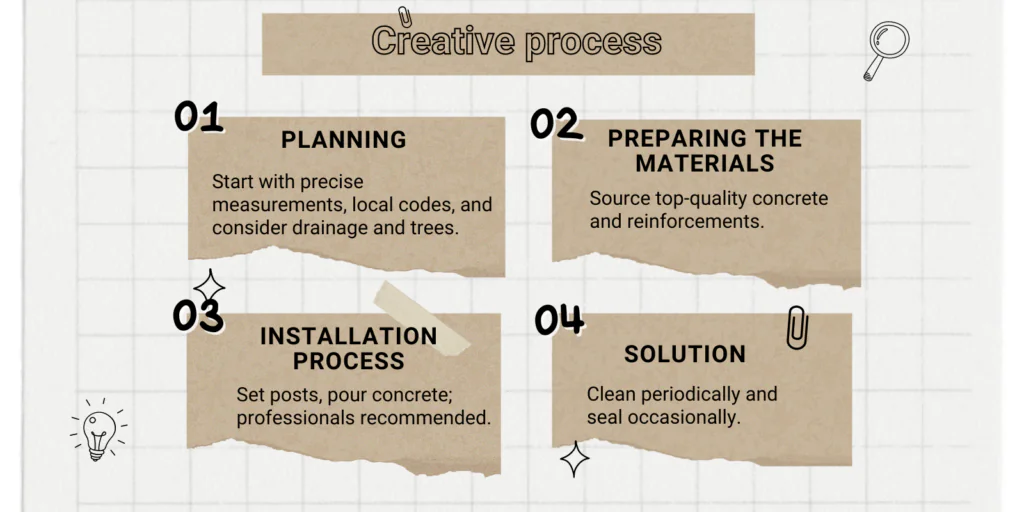Have you ever considered your property and thought, “How can I enhance its aesthetic appeal while also boosting security?” You’re not alone; many homeowners grapple with this issue. Traditional wooden or chain-link fences may not offer the durability or visual impact you’re after. Concrete fences blend resilience with modern design, offering a range of stylish options that can completely transform your property.
Concrete fences are not just barriers but a design statement that fuses utility and aesthetic flair. Whether leaning towards simple panels or intricate geometric designs, modern concrete fences have covered you. Not only do they provide a robust boundary around your property, but they also add an architectural element that can make your outdoor space visually compelling.
This guide will walk you through the ultimate trends in modern concrete fence designs for 2023, ensuring you find a style that matches your home and taste. Stick around to uncover ideas that could give your property a complete makeover.
Why Concrete Fences are the Future

Durability and Longevity of Concrete
Concrete is synonymous with durability. Built to withstand various environmental factors like rain, wind, and extreme temperatures, a concrete fence can last for decades with minimal maintenance. I’ve seen properties with concrete barriers that have stood the test of time, requiring only occasional cleaning to keep them looking fresh. Unlike wooden fences that can rot or metal ones that may rust, concrete stays solid and secure, retaining its original appearance for years.
Modern Appeal of Concrete Fences
Now, let’s talk about aesthetics. Gone are the days when concrete was only for industrial or uninspired designs. With advancements in technology, concrete fences now come in an array of stylish options, from smooth finishes to intricate geometric patterns.
Modern concrete designs can genuinely elevate the look of your property, creating an elegant barrier that complements your home’s architectural style. Having worked with various fencing materials over the years, I can tell you that concrete offers the most design flexibility. Whether your home is traditional or contemporary, there’s a concrete fence design out there that’s perfect for you.
Cost-Effectiveness of Concrete Fences in the Long Run
Cost is always a critical factor when considering any home improvement project. While the initial outlay for a concrete fence might be higher than other materials, looking at the bigger picture is crucial. Concrete is a cost-effective option when you factor in low maintenance costs and the fence’s longevity. Over time, you’ll find that the initial investment pays off, especially when you don’t have to worry about frequent repairs or replacements.
How to Choose the Best Concrete Fence Design

Considerations Based on Purpose and Location
When you’re selecting a concrete fence, the first thing to consider is the purpose it will serve. Is it mainly for aesthetics, or are you looking for increased security or privacy? The location of the fence also plays a role. For instance, a solid concrete fence can serve as a windbreak if you live in a windy area. I’ve consulted with clients living near busy roads who opted for concrete fences to reduce noise, a solution that worked wonderfully for them.
Choosing the Right Design Based on Your Home’s Architectural Style
Your fence should be an extension of your home’s architectural style, whether modern, traditional, or something else. I’ve worked on various projects where the right design helped to pull together the home’s overall aesthetic. A minimalist concrete fence, for example, would beautifully complement a modernist house, whereas a decorative design might suit more classical architecture.
Evaluating a Design Based on Maintenance Needs
Maintenance is an aspect that people often overlook when choosing a fence. While concrete is relatively low-maintenance, some designs and finishes may require more upkeep than others. For example, colored or textured concrete might need regular cleaning to maintain its appearance. I always discuss this with clients upfront to ensure they are prepared for any maintenance commitments.
| Considerations Based on Purpose and Location | Consider its primary function, such as aesthetics, security, or privacy. Location matters, with fences potentially serving as windbreaks or noise barriers. |
| Choosing the Right Design | The fence design should resonate with your home’s architectural style, enhancing its overall aesthetic appeal. |
| Evaluating a Design | While concrete fences are generally low-maintenance, some designs might require more care, especially colored or textured ones. |
Choosing a concrete fence is not just about picking the first design that catches your eye. It’s about finding a style that aligns with your needs, complements your home, and is easy to maintain. With years of experience in advising clients on the best fencing options, I can confidently say that when you consider these factors, you’re more likely to be satisfied with your investment in the long run. So, trust the process and make an informed decision that suits your style and functional needs.
Step-by-Step Guide to Building a Concrete Fence

Planning
The first step in building a concrete fence is the planning phase. Accurate measurements are essential, as is checking local building codes and securing any necessary permits. This may also include having your property line professionally surveyed. In my experience, a well-executed plan sets the stage for a smooth installation process. Make sure to consider factors like drainage and proximity to trees, as these can affect the longevity and effectiveness of your fence.
Preparing the Materials
The second step involves preparing your materials. If you opt for a combination design, you’ll need to source high-quality concrete, reinforcing materials like steel bars, and any other elements like wood or metal. Given the number of projects I’ve managed, I can’t stress enough the importance of using top-grade materials. It may be tempting to cut costs here, but remember that you’re investing in a long-term structure that should withstand various elements.
Installation Process
Once planning and preparations are complete, you move on to the installation. This typically involves setting the posts, installing rebar for reinforcement, and pouring the concrete. It’s a labor-intensive process, and while you could attempt a DIY, I usually recommend hiring professionals to ensure the job is done right. In the multiple installations I’ve overseen, professional work almost always yields the most satisfactory results, from providing the concrete level and consistent to ensuring the fence is sturdy and stable.
Maintenance
After your concrete fence is installed, maintenance is relatively straightforward. Regular cleaning and occasional sealing can go a long way in preserving the look and integrity of the wall. Having advised clients on maintaining various fences, I find that concrete is one of the least demanding materials, offering an outstanding balance of aesthetic appeal and functional resilience.
Conclusion
In summary, 2023 has ushered in a new era of concrete fence designs that are both innovative and functional. From minimalist designs to combination approaches that mix concrete with wood or metal, there’s something for every aesthetic preference and practical need. And let’s not forget the importance of planning and using top-grade materials for a long-lasting, sturdy fence. Having been closely involved in this industry, I can vouch for the enduring quality of these designs.
If you’re looking for a new fence this year, I highly encourage you to consider these concrete options. With their exceptional balance of durability, aesthetic appeal, and cost-effectiveness, you’re making an investment that will not only enhance your property but also stand the test of time. Trust me, opting for a modern concrete fence design is a choice you won’t regret.


